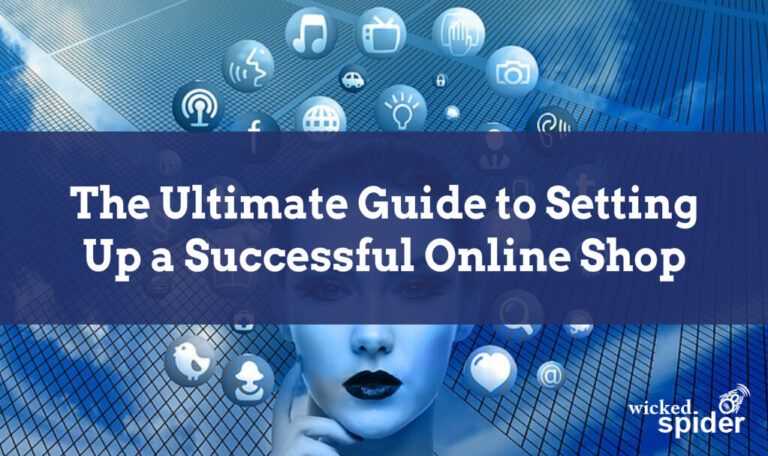Introduction
The world of retail has been changing since the dawn of time, but it has perhaps experienced more change in the past 10 years than the previous 1,000.
Online shopping has become more and more popular, threatening established offline retailers massively (that could be subject of another post sometime couldn’t it). It has transformed the way people buy forever.
If you want to enter this world and setup an online shop of your own, then you have made a wise decision.
Ecommerce is taking over how we all shop and you want to join the online market.
However, there’s a fly in the ointment: how do you go about setting up a successful ecommerce site? “Successful” being the important word here. Anyone can setup an online shop. But what do you need to do to make it a successful shop?
Get your landing page right
Your landing page is your opportunity to make a good first impression. It is the first thing a potential customer will see, so it needs to represent your shop in the best possible way. Here are a few improvements you can make to your landing page today:
- Use a primary headline that is designed to be eye-catching; something that will make people want to know more.
- Add customer testimonials to help give the page an authentic feel right from the moment a prospective customer lands on it.
- Use high quality images; it is better to have one great image than several low-quality images
- Introduce a call to action button as quickly as possible, so those who are ready to buy are able to do with ease.
- Use contrasting colours to help draw the eye of the reader and make the page as distinctive as possible.
- Add your social media buttons so customers can learn more about your company if they wish to.
Make sure your site is mobile responsive
Ecommerce sites have to be mobile responsive. 62% of customers have made a purchase online via their mobile phone, so you have to ensure your site is ready for mobile sales.
Perfect your product photos
Product photos might not be the be-all and end-all of the success of an ecommerce site. They are, though, arguably the most important single component when it comes to generating a sale. If product photos are poor or lacking in some way, few customers will feel brave enough to buy “sight unseen”.
That’s why it’s essential that you abide by the essential rules of product photography:
- Product photos should be high quality. You can hire a professional or use a DSLR yourself; but whichever option you use, the images should be the highest possible quality.
- Product photos should be well lit. A professional photographer will manage this for you, but if you’re photographing for yourself, this is an issue you will need to examine in depth. At the very least, you’ll want to make your own light tent to photograph your products in.
- Product photos should vary what they show. You need at least two photos of the whole product, and then photographs of individual key points. These include detailing, important labels, and other key points.
- For smaller items, a size reference is also useful. Coins are popular choices, though a tape measure tends to look more professional.
Enhance the user experience with product videos
Product videos are a great way of showcasing a product, and are particularly suited to products with moving parts. Here’s a few tips for creating great product videos:
- You don’t have to talk on the video, but if you’re going to, then script yourself. If you “uhm” and “aah” your way through a video, this won’t reflect the product in the best possible light.
- If you just want to demonstrate the product in motion without having to actively ‘present’ it, upbeat music is a good choice.
- Keep the video short and useful. There’s no need to go for a full-on infomercial; keep it short, light and easy to digest.
Write compelling product descriptions
When you’ve got your images, you now need to write the descriptions for those images. Here are a few aspects you should be thinking about:
- Focus on the benefits to the buyer. What problem is the product going to solve? How is it going to make their lives easier?
- Use an SEO keyword in your description, provided it blends seamlessly in the text. SEO is important, but the descriptions can’t be keyword stuffed or compromised just to accommodate it. The primary purpose of descriptions is to tempt someone to buy, not to increase the visits to the page.
- Use short bullet points to highlight the key advantages of the product, then a longer paragraph that expands on these bullet points.
- The longer description can incorporate more keywords if you wish but, again, don’t let this compromise the actual description.
- Integrate customer testimonials into the product description. This way, prospective customers can see the item in question is useful both in concept and in practice.
- Include technical information and specifications wherever possible. Size, measurements, capabilities, compatibility with existing products. These are all things that most customers want to know before they buy. As this information is quite dry, it’s best to keep it out of the main descriptive sections, but a “tech specs” table is always worth including.
Use calls to action throughout the site
Calls to action are exactly that; an eye-catching part of the site that is designed to prompt the desired behavior from a customer. In most cases, calls to action are used to try and encourage someone to buy a product. They can also be used to encourage email list sign ups or follow the company on social media.
- Calls to action should be distinct from the rest of the site. Bright colors and text changes are commonly used to help distinguish the call to action from its surroundings.
- Simplicity is the key for a call to action. Opt for basic statements such as “Buy Now!” or “Try Here!”. Anything more in-depth than this risks losing the urgency that a call to action should be seeking to create.
- Calls to action work best when they are placed in the top-half of your website. As a call to action is an immediate command, you want your customers to see it instantly rather than having to scroll to find it.
Encourage people to register with the site
Not everyone who wants to buy from your online shop will want to register, but it’s very beneficial to you if they do. A customer registering helps you to build your email list and gives you better options for promotions and marketing in the future.
- Provide incentives for customers to register; for example, you could offer 10% off their first order when they sign up to the site.
- Explain the benefits of registering to customers, such as easier order tracking and simpler management of their purchase history.
- Make registration easy; a name and an email address is more than sufficient to begin with if that works for your business. Customers are liable to abandon a registration attempt if they have to fill in too many fields, so keep things simple. You can always ask for further details, such as their address and phone number, when they make a purchase.
Simplify the checkout process
Buying from your site should be simplicity itself. Some customers will simply abandon a cart if the process is taking too long, so getting this area right is key for converting sales:
- Keep your checkout basic. Adding additional steps — for example “items you might be interested in!” pages — before the checkout is not recommended. Use these after checkout, rather than before: get the sale first!
- Allow guest checkout. As beneficial as it may be for customers to register on your site, it’s more important to get the sale, so don’t make registration compulsory to buy. Many customers prefer guest checkout, so it’s important you allow this option for those who want to use it— hopefully, they will sign up eventually anyway.
- Offer as wide a range of payment methods as you can. The last thing you want is for a customer to click away from your website if you don’t accept their preferred payment method.
Add supplementary pages
Finally, build trust with your customers by providing supplementary information. There are a few different pages you may want to add:
- FAQ pages help to reduce the amount of time you will spend answering the same questions to customers. This can help customers feel more confident about the buying process.
- Policy pages are a must. Be transparent and open with these pages, and make it clear where the customers stands and what their rights are. Use clear, simple English. You don’t want to confuse your customers with impenetrable legalese.
- A contact page is an absolute must for any ecommerce site. This should include relevant phone numbers, your email address, a separate contact form, and links to the site’s social media accounts. Not only does this reassure customers that they will be able to discuss any problems with you, but it can also help to boost your tribe.
Successful ecommerce shops take a lot of work, a lot of instinct, and even a tiny bit of luck sometimes. However, with the right ingredients, your ecommerce shop could soon be flying high alongside the biggest and the best.





